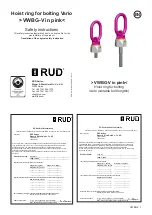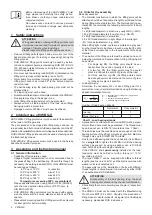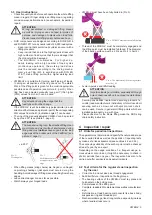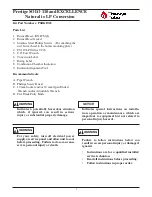
VWBG-V
2
Before initial usage of the RUD VWBG-V hoist
rings please read carefully the safety instruc-
tions. Make sure that you have understood all
subjected matters.
Non-observance can lead to serious personal
injuries and material damage and eliminates
warranty.
1 Safety instructions
ATTENTION
Wrong assembled or damaged lifting points as well
as improper use can lead to injuries of persons and
damage of objects when load drops.
Please inspect all lifting points before each use.
• Remove all body parts (fingers, hands, arms, etc.) out of the
hazard area (danger of crushing or squeezing) during the
lifting process.
• RUD VWBG-V lifting points must only be used by instruc-
ted and competent persons considering BGR 500 / DGUV
100-500 and outside Germany noticing the country specific
statutory regulations.
• Do not exceed the working load limit (WLL) indicated on the
lifting point (except vertical loading - see chart 3).
• Not suitable for permanent turning operations under load.
Lifting point cannot be turned 90° to the bolt-on direction
under full load.
• The ball bearing resp. the bush bearing disc must not be
disassembled.
• The load ring must not be bend.
• No technical alterations must be implemented on the VWBG-V.
• No people may stay in the danger zone.
• Jerky lifting (strong impacts) should be prevented.
• Always ensure a stable position of the load when lifting.
Swinging must be prevented.
• Damaged or worn VWBG-V must never be utilised.
2 Intended use of VWBG-V
RUD VWBG-V lifting points must only be used for the assembly
at the load or at lifting means.
They are intended to be hinged into lifting means and can be
turned under load, but not under full load, especially not in the 90°
direction. Not suitable for permanent turning operations under load.
RUD VWBG-V lifting points can also be used as lashing points
to attach lashing means.
RUD VWGB-V lifting points must only be used in the hereby
described operation purpose.
3 Assembly- and instruction manual
3.1 General information
• Capability of temperature usage:
Usage at higher temperatures is not recommended due to
the grease filling in the ball bearing. Should this though be
necessary, the working load limit (WLL) of the VWBG-V must
be reduced as follows:
-
-40°C up to 100°C
no reduction
-
100°C up to 200°C
minus 15 %
-
200°C up to 250°C
minus 20 %
-
250°C up to 350°C
minus 25 %
-
Temperatures exceeding 350°C are prohibited!
Please pay attention when using DIN EN 7042 (DIN 980)
nuts the max. operation temperature of 150°C (acc. to
DIN EN ISO 2320).
• RUD VWBG-V lifting points must not be used with aggres-
sive chemicals such as acids, alkaline solutions and their
vapours.
• Please mark mounting position of lifting point with a coloured
contrast paint for better visibility.
3.2 Hints for the assembly
Basically essential:
• The material construction to which the lifting point will be
attached should be of adequate strength to withstand forces
during lifting without deformation. The German testing au-
thority BG, recommends the following minimum for the bolt
lengths:
1 x M (thread diameter) in steel
(min. quality 235JR [1.0037])
1.25 x M (thread diameter) in cast iron (e.g. GG 25)
2 x M (thread diameter) in aluminium
2.5 x M (thread diameter) in light alloys of low strength
(M = thread size/diameter, e.g. M20)
• When lifting light metals, nonferrous metals and gray cast
iron the thread has to be chosen in such a way that the WLL
of the thread corresponds to the requirements of the base
material.
• The position of the lifting points must be carried out in such
a way that unintended movement like turning or flipping will
be avoided.
•
For single leg lifts, the lifting point should be ver-
tically above the centre of gravity of the load.
•
For two leg lifts, the lifting points must be equidi
stant to/or above the centre of gravity of the load.
•
For three and four leg lifts, the lifting points should
be arranged symmetrical around the centre of gravi-
ty, in the same plane if possible.
• Load symmetry:
Determine the necessary WLL of each lifting point for a
symmetrical or an unsymmetrical load by using the following
physical calculation formula:
W
LL
= necessary WLL of lifting point / single strand
G
= weight of load
n = number of load bearing strands
ß
= inclination angle of single strand
G
n x cos ß
W
LL
=
Number of load bearing strands:
Symmetric
Unsymmetric
two leg
2
1
three / four leg
3
1
Chart 1: Load bearing strands
• A plane bolt-on surface (with a minimum ØD) with a perpen-
dicular thread hole must be guaranteed. The thread must
be carried out acc. to DIN 76 (countersink max. 1.05xd).
• Thread holes must be machined deep enough so that the
bearing surface of the lifting point will be supported. Machine
through holes up to DIN EN 20273-middle.
• Due to the ball bearing and the bush bearing it is sufficient
for a
single lift
to tighten the VWBG-V until the bearing
surface has support by using a spanner acc. to DIN 895
resp. DIN 894, without using an extension.
If the VWBG-V shall
permanently
installed at the load,
tensioning must be carried out with a torque (+/- 10 %)
according to chart 2.
• The type VWBG-V can be supplied with different thread
lengths (see Fvario in chart 2), and the metric versions with
washer und crack detected nut.
The assembly resp. the installation of bolts with different
thread lengths is only allowed, if camed out by either RUD
or an authorized RUD distributor.
ATTENTION
Disassembly of the ball bearing resp. the bush
bearing disc carried out by the user is forbidden.
• Check finally the correct assembly (see chapter 4, Inspection /
repair).
• The VWBG-V must not be loaded with the Manufacturing
Proof Force MPF (2.5 x WLL). Should at the production of
lifting means or similar products, a singular proof loading be
necessary, please ask RUD in advance.























